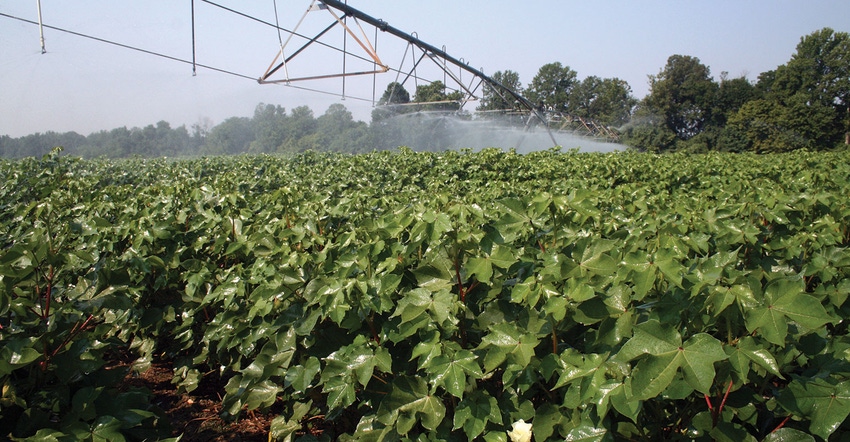
Variety improvement and timely irrigation have increased Mississippi's cotton yield per-acre average 500 pounds since 1980. A shift toward earliness has decreased cotton's maturity window 30 days the last 60 years.
"We're making a bigger crop in less time," says Darrin Dodds, professor and department head, Plant and Soil Sciences, Mississippi State University, speaking at this year's National Conservation Systems Cotton and Rice Conference. "That puts a big demand on resources, and water is a key resource in yield development.
"Faster variety turnover makes it difficult to learn how to irrigate specific varieties," Dodds says. "About the time you learn to irrigate a given variety, it's gone, and you have to start figuring out how to irrigate the next one."
Yields from irrigation
Dodds has never been a fan of pre-square irrigation. "If it gets dry after planting, especially around the end of May to June, some producers get nervous and want to irrigate," Dodds says. "Irrigating that early generally does not improve retention, quality, or yield. In our current farm economy, if it's not putting money in a producer's pocket, I don't advise it."
Cotton normally starts squaring after 35 days. "The key time for irrigation is during the first 30 days of bloom development," Dodds says. "That's usually the month of July. Once we get to August and bolls start opening, irrigating might hurt more than help."
Dodds' box map studies show irrigation helps retain fruit positions incrementally up the plant. "We make a little more cotton on nodes 4 to 8 and we make a good bit more on the first position fruit out from the main stem," Dodds says. "Where we really make our yield gains from irrigation is in the middle of the plant, around nodes 11 to 15."
Good infiltration is a must, especially in soils that tend to crust. How you irrigate is critical.
Irrigation patterns, timing
Gauging the efficiency of an irrigation program can be tricky. "If it takes 18 hours to row irrigate a field the first time and only 8 hours the second time, you should consider if you are getting adequate infiltration," Dodds says. "If you don't have soil moisture sensors, get a shovel, dig a hole and look. That second shot of water probably just skated over the top of the soil."
Surge valves and cover crops are options. A cover crop will improve water infiltration. "A $2,500 surge valve, over time, will pay for itself in water savings because it will alternate water back and forth, giving it more time to soak into the soil," Dodds says.
"In addition, our alternate row irrigation trials show no benefit compared to watering every row, unless you've got sandy soil that doesn't allow water to wick across. If you're farming a silt loamy soil, I'd tell you to water every other row."
Irrigation timing can affect yield potential too.
Results from a study by one of Dodds' former graduate students evaluated irrigation timing incrementally from stages covering planting to bloom, up to pink bloom to boll opening. "During the study, the field wasn't kept too wet early, and we didn't let it get too dry," Dodds says. "We found that 90 kilo-pascals, which is the force created when water pulls away from a soil sensor, is the threshold where we initiated irrigation leading to optimized yields."
Dodds has seen too many farmers irrigating two or three weeks past first cracked boll. "I try to talk them out of it because many times that leads to hard lock or boll rot," Dodds says. "If bolls start opening, I would advise terminating irrigation unless you are in a substantial drought condition. Data tell me it won't lead to extra yield."
Dodds likes to see a full soil profile of water going into first bloom. Toward the end of the season, "…if you get to first cracked boll and your moisture levels are good, roll up the pipe and get the picker ready," Dodds said.
About the Author(s)
You May Also Like




